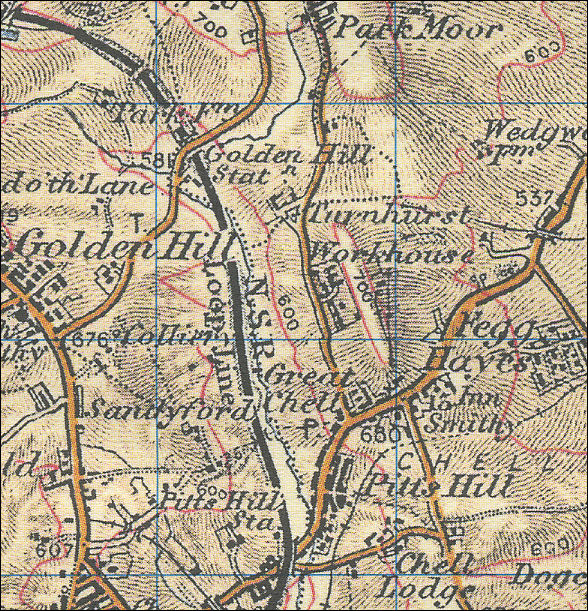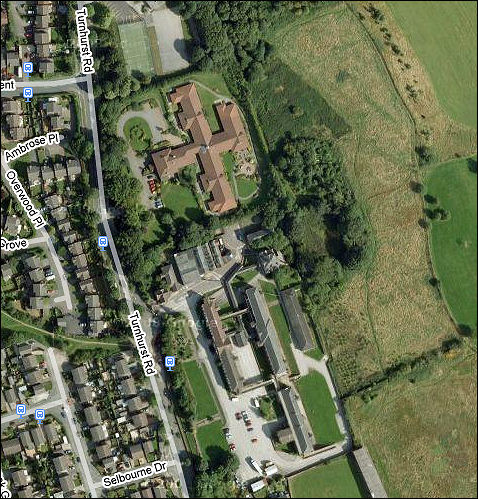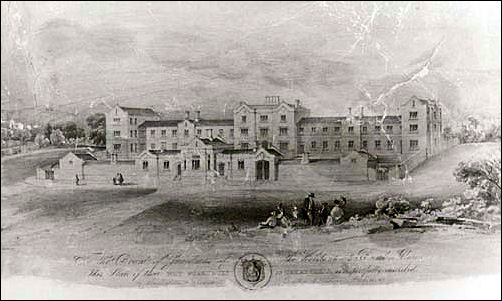|
In his book Clayhanger, Arnold
Bennett described the Victorian workhouse at Chell as the Bastille....

the face of Arnold
Bennett watches over a family wending their way to the workhouse
from a mural in the Potteries Shopping Centre
"The Bastille was on
the top of a hill about a couple of miles long, and the journey thither
was much lengthened by the desire of the family to avoid the main road.
They were all intensely ashamed; Darius was ashamed to tears, and did
not know why; even his little sister wept and had to be carried, not
because she was shoeless and had had nothing to eat, but because she was
going to the Ba-ba-bastille; she had no notion what the place was. It
proved to be the largest building that Darius had ever seen; and indeed
it was the largest in the district; they stood against its steep sides
like flies against a kennel. Then there was rattling of key-bunches, and
the rasping voices of sour officials, who did not inquire if they would
like a meal after their stroll. And they were put into a cellar and
stripped and washed and dressed in other people's clothes, and then
separated, amid tears. And Darius was pitched into a large crowd of
other boys, all clothed like himself. He now understood the reason for
shame; it was because he could have no distinctive clothes of his own,
because he had somehow lost his identity. All the boys had a sullen,
furtive glance, and when they spoke it was in whispers."
Clayhanger Arnold Bennett
|
In 1838 Tunstall became part of the new
Wolstanton and Burslem Union. The union workhouse was built in
Turnhurst Road, Chell, c. 1838–9, 'a palatial structure' costing
£6,200 and providing accommodation for 400 inmates.
The workhouse remained in use after the
amalgamation with Stoke Union in 1922 and became the Westcliffe
Institution. The original structure, of yellow brick with stone
dressings in the 'Tudor' style of the period, continued to form part
of a large group of buildings on the east side of Turnhurst Road - it
became a home for poor people until 1975 when the 300 residents were
moved into five purpose built homes in other parts of the city. It was
demolished in 1993.
A range was built to the south as a
hospital in 1894. This became the Westcliffe Hospital.

The workhouse on the
road between Great Chell and Packmoor - 1902

the Westcliffe
Hospital on Turnhurst Road - 2008
(Google Maps)
 |
The poor house that
Bennett based his emotive writings on, was in fact the poor house of
Chell. Chell is a suburb of Tunstall on the easterly road to the ancient
settlement of Moorland Biddulph. It was to this place that the truly poor
of the district would be incarcerated in the mid 1800's.
The Union Workhouse or the
Bastille in Bennett's novel "Clayhanger" would strike fear into the
hearts of the people of the area. The residents of Tunstall would hurry
past its door, not daring to look up or breath the air around the building
for fear that they would catch the extreme poverty which seemed to afflict
some families, like the nameless horror of an unspeakable disease. The
horrors that awaited the poor residents of the Bastille so
graphically captured by Bennett.
"In the
low room where the boys were assembled there fell a silence, and Darius
heard someone whisper that the celebrated boy who had run away and been
caught would be flogged before supper. Down the long room ran a long
table. Some one brought in three candles in tin candlesticks and set
them near the end of this table. Then somebody else brought in a picked
birch-rod, dripping with salt water from which it had been taken, and
also a small square table.
Then came some officers, and a clergyman, and then, surpassing the rest
in majesty, the governor of the Bastille, a terrible man. The governor
made a speech about the crime of running away from the Bastille, and
when he had spoken for a fair time, the clergyman talked in the same
sense; and then a captured tiger, dressed like a boy, with darting
fierce eyes, was dragged in by two men, and laid face down on the square
table, and four boys were commanded to step forward and hold tightly the
four members of this tiger. And, his clothes having previously been
removed as far as his waist, his breeches were next pulled down his
legs.
Then the rod was raised and it descended swishing, and blood began to
flow; but far more startling than the blood were the shrill screams of
the tiger; they were so loud and deafening that the spectators could
safely converse under their shelter. The screaming grew feebler, then
ceased; then the blows ceased, and the unconscious infant (cured of
being a tiger) was carried away leaving a trail of red drops along the
floor."

A print of Chell
Workhouse, circa 1839.
picture:
©
Exploring the Potteries
 |
![]()
![]()
![]() also see Poverty and the poor
law in Stoke-on-Trent
also see Poverty and the poor
law in Stoke-on-Trent